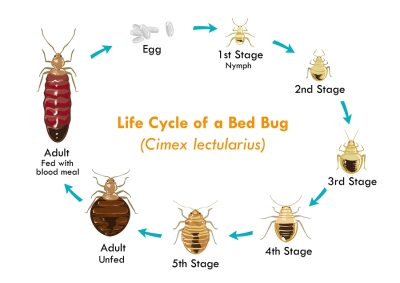
Bed bugs are a nightmare for many people. These tiny insects are notorious for infesting our homes and causing sleepless nights. To effectively combat them, it’s crucial to understand the bed bug life cycle and its various stages of infestation.
The bed bug life cycle consists of five stages: egg, nymph (five instars), and adult. Let’s delve deeper into each stage to gain a better understanding of these resilient pests.
Firstly, let’s start with the eggs. Female bed bugs lay hundreds of tiny eggs, usually in batches of 10-50, in secluded areas near their hosts, such as cracks, crevices, or the seams of mattresses. These eggs are almost invisible to the naked eye, measuring only about 1mm in length, and have a pearly white color. The female bed bug can lay up to five eggs daily, and within 1-2 weeks, these eggs hatch into nymphs.
The nymphs are the second stage of the bed bug life cycle. Once hatched, they are translucent and resemble smaller versions of adult bed bugs. They require a blood meal to grow and molt between each of their five instars, shedding their exoskeleton as they advance to the next stage. The molting process is crucial for their growth, and each time they molt, they become darker and larger. Nymphs are usually light tan or yellowish-brown and range from 1.5mm to 4.5mm in size. During this stage, the nymphs will feed every few days, and if conditions are favorable, they can develop into adults within four to five weeks.
The final stage of the bed bug life cycle is the adult stage. Adult bed bugs are around 4.5mm to 7mm in length, about the size of an apple seed. They have flat, oval-shaped bodies with a reddish-brown color, turning darker after feeding. Adult bed bugs are nocturnal and live solely on blood meals from humans or other warm-blooded animals. They have a specialized feeding apparatus designed to pierce the skin, inject an anticoagulant to prevent blood clotting, and draw out blood. Bed bugs typically feed for about five to ten minutes before retreating to their hiding spots. They can survive for months without feeding, making them highly resilient.
Understanding the bed bug life cycle is crucial for effective eradication. Firstly, eggs and nymphs are harder to detect, as they are smaller and often hidden in difficult-to-reach areas. Female bed bugs have the ability to lay eggs in multiple locations, making it easier for infestations to spread rapidly.
Furthermore, the different life cycle stages of bed bugs make them more challenging to eliminate completely. Traditional DIY methods, such as pesticide sprays, often fail to eradicate all life stages, leading to recurring infestations. To combat bed bugs effectively, professional pest control methods that target all life stages, including eggs, are essential.
Preventing bed bug infestations is much easier than dealing with existing ones. Regularly inspecting your home and luggage after travel, washing and drying bedding on high heat, and sealing cracks and crevices are useful measures for prevention. If you suspect a bed bug problem, it’s crucial to act quickly to prevent their numbers from increasing.
In conclusion, understanding the bed bug life cycle and its stages of infestation is essential for effective eradication. From the minuscule eggs to the resilient adult stage, each phase presents unique challenges. Employing professional pest control methods and implementing preventative measures is crucial to combat these resilient pests and restore peace and comfort to our homes.


















